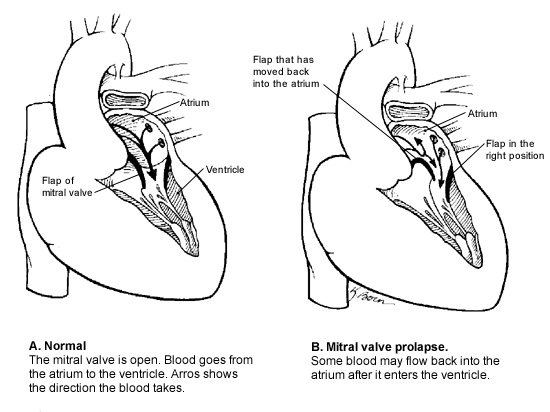
Am Fam Physician. 2000;61(11):3353-3354
See related article on mitral valve prolapse.
What is the mitral valve?
The mitral valve controls the flow of blood between two “chambers,” or “rooms,” of your heart, called the left atrium and the left ventricle. Normally, blood flows only from the atrium to the ventricle. When the heart relaxes in between beats, the two “flaps” of the mitral valve swing open to let blood flow from the atrium to the ventricle. The “hinges” of the flaps keep them from opening the other way. When the heart beats, blood is pushed out of the ventricle and into the blood vessels that carry it to the rest of your body.

What is mitral valve prolapse?
If you have mitral valve prolapse, your flap hinges don't work well. One of the flaps moves back into the atrium when the heart beats. This can let blood flow from the ventricle back into the atrium.
About one in 20 Americans has mitral valve prolapse. People are usually born with it. More women have it than men.
How do I know that I have mitral valve prolapse?
Sometimes people with mitral valve prolapse have symptoms, or feelings, that go along with this condition. Here are some of these symptoms:
Feeling like your heart is racing or is skipping beats
Chest pain that comes now and then
Shortness of breath
Dizziness
Anxiety or panic
Your doctor can find mitral valve prolapse during a regular exam. When listening to your heart with a stethoscope, your doctor may hear a clicking sound. The flap makes the click. If blood is flowing back into the atrium, your doctor will hear a “whooshing” sound. This sound is called a murmur. To find out how well your valve is working, your doctor will have you get an echocardiogram. The echocardiogram is a special picture of your heart that shows your valve as the blood flows through it. This can help your doctor decide if you need treatment.
How is mitral valve prolapse treated?
Most people with mitral valve prolapse don't need any treatment. In fact, this condition usually has no effect on your health. About two of every 100 people with this condition have complications. You may need surgery to fix the valve if your valve is too leaky or if you are having lots of symptoms. You may also have to limit your participation in competitive sports. Ask your doctor if you are in this group.
If your mitral valve prolapse causes chest pains or other symptoms, your doctor might prescribe medicines such as beta blockers to make your symptoms better.
Some people get an infection in the leaky valve when they have surgery or dental work. You might take antibiotics before surgery or dental work to prevent this infection. Remind your dentists and doctors that you have mitral valve prolapse so that you can get a prescription for antibiotics when you are going to have surgery or dental work.
Where can I learn more about mitral valve prolapse?
You can find out more about mitral valve prolapse at the American Heart Association's Web site: http://www.amhrt.org.